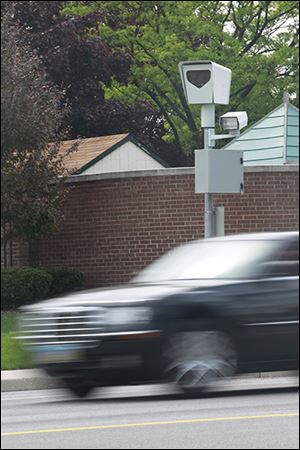
New bill would regulate Ohio’s red-light cameras
Critics argue legislation amounts to a ban
5/23/2014
A vehicle passes a red-light speed camera near the intersection of Cherry Street and East Delaware Avenue in Toledo.
COLUMBUS — A bill introduced this week claims to preserve and regulate red-light and speed-enforcement cameras used by Toledo and other cities in Ohio, but critics countered that the measure would still amount to a practical ban on such devices.
Senate Bill 342, sponsored by Sen. Bill Seitz (R., Cincinnati), would allow cities to keep their cameras but require that a police officer personally witness violations caught by the cameras before civil citations may be issued.
“These devices are simply a money grab,” he told the Senate State Government Oversight Committee. “Fines are meant to be a punishment for violators, not a source of income for cities.
“The majority of money garnered from these tickets is not staying in-state,” Mr. Seitz said. “Sixty percent of the funds are shipped out-of-state to the companies that own the photo-monitoring devices. Therefore, the monetary burden placed on Ohioans who are ticketed is supporting the economy in other states.”
A separate bill passed the House a year ago, 61-32, to outright ban traffic cameras for red-light enforcement and allow them for speed enforcement only in 20 mph school zones when a police officer is present.
That bill, however, has gone nowhere in the Senate despite pressure to respond to the suburban Cincinnati village of Elmwood Place, where the courts shut down a program one judge called a “scam that the motorists can’t win.”
“[Senate Bill 342], in effect, is a ban bill,” said Sen. Kevin Bacon (R., Columbus), a committee member who prefers statewide uniform regulation of camera programs as an alternative to banning them.
“No municipality or village is going to use an electronic photo device and a live officer,” he said. “So the rest of the bill that creates a regulatory scheme for it, in my opinion, is never going to be used.”
Critics also argue that there would be no need for a civil citation for violations captured by the camera, punishable by a flat fine, if a police officer is there to issue a criminal citation. In addition to a fine, a criminal violation can carry court costs, points against the offending driver's license, and a report to the driver’s auto insurer.
In Toledo, the fine under the camera program for running a red light is a flat $120, $90.25 of which is kept by the city with the rest going to operator RedFlex Traffic Systems.
In some respects, the bill is similar to one passed in 2006 only to be vetoed by then Gov. Bob Taft who called it a violation of cities’ home-rule authority. Since then, the Ohio Supreme Court has generally upheld the constitutionality of such programs, although it is scheduled to hear arguments June 11 in a new case specifically targeting the administrative hearing and ticketing process used by Toledo motorists to challenge their citations. The Seitz bill would prohibit the issuance of citations in school speed zones if the driver was traveling 5 mph or less over the limit and, at other locations, less than 10 mph over the limit.
Contact Jim Provance at: jprovance@theblade.com or 614-221-0496.